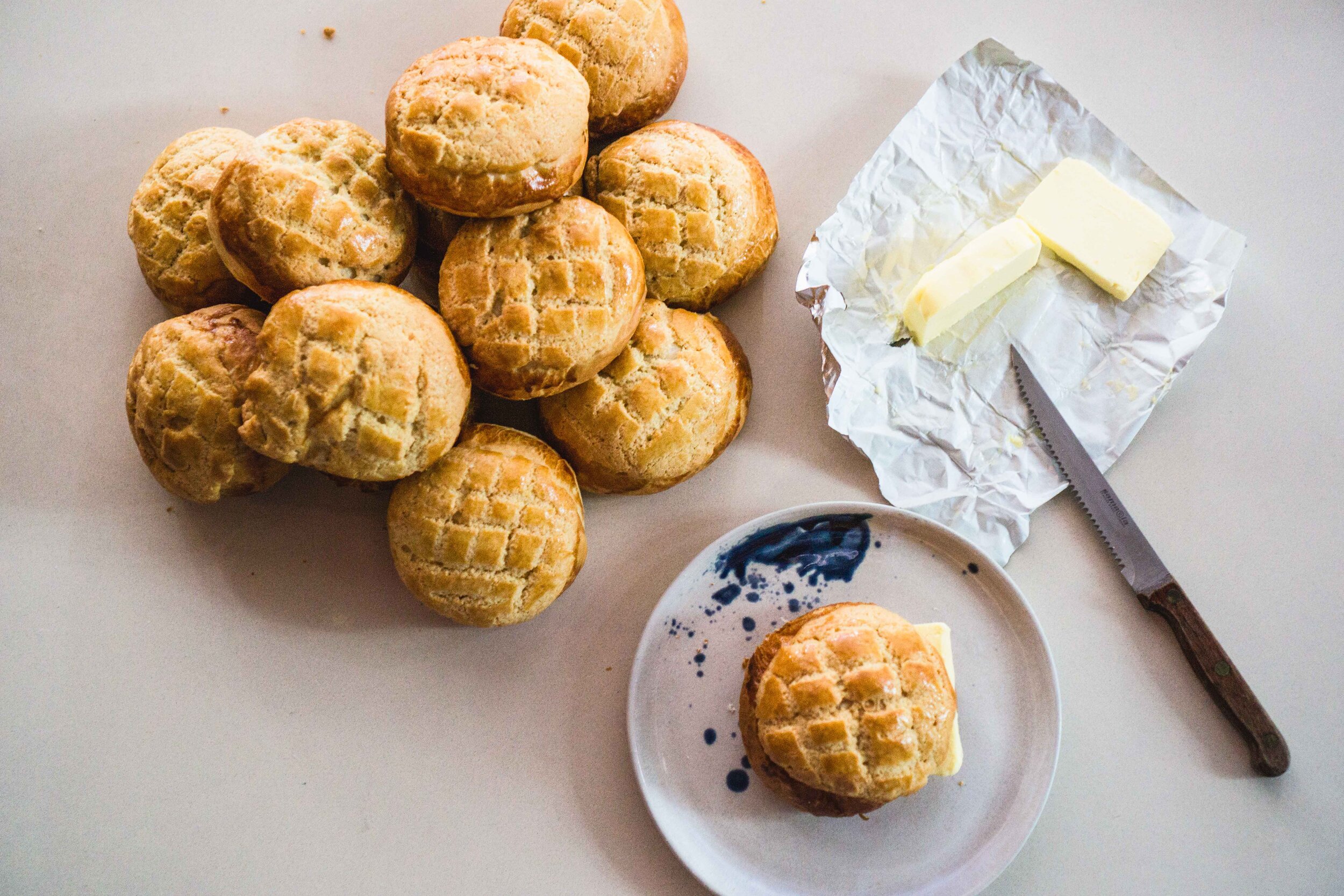Pineapple Buns (Bo Lo Bao; 菠蘿包)
With a top crust like a pineapple, a build like a polo ball, and a soft, supple, bao-like inside, pineapple buns, or bo lo baos (菠蘿包) are confusingly, though perhaps aptly, named. To many, it belongs in the upper echelons of the Asian pastry world. But to me, embarrass as it might be to admit, I’ve never been big on them.
People rave about its buttery aroma as it bakes up, that sweet smell that wafts out of bakeries and cha chaan tengs like Kam Wah and Tsui Wah in Hong Kong. But if I wanted buttery aroma, a brioche takes buttery to dizzying heights. Others love bo lo bao’s soft insides, its supple texture of bread that tears at the softest bite . If I wanted that, a classic Japanese milk bread roll, to me, is the pinnacle of pillowy suppleness. And the piece de resistance of a bo lo bao—its crusty, craggly top, is what strikes many as the most appealing factor of a bo lo bao. But if I wanted a nice, burnished, crispy crust, I’d go for a croissant, a cookie, a kouign amann perhaps, or maybe even nibble on the crusty top of a well-baked banana bread.
I know I sound like a hater. But point is, I never got the hype of bo lo baos.
But then, I made my own.
Through kneading and baking this classic Hong Kong pastry, I found a better appreciation of it. You might say it’s an awakening, an enlightening. It’s funny how making food with your own two hands can change your mind about dishes you never thought much of. And after making them, and sharing them with loved ones, it’s precisely those things I mentioned above, those aspects of bo lo bao that I never thought much of, all combined, that makes me love these buns.
Sure, brioches might give off a more buttery scent, but bo lo baos have a subtler, sweeter smell, like a mix of butter, milk and the freshness of a baby out of a bath (that sounds hella creepy but I promise you I’m not). And yes, Japanese milk bread might yield a softer, suppler interior, but why split hairs when you can incorporate that into bo lo baos. (And that’s what I did in the recipe below, heh.) And finally, that crumbly crust. I admit, croissant, kouign amanns, and babkas might have crags and valleys that turn it extra crispy post-baking, but the crumb of a bo lo bao is different. It crumbles like a cookie, tastes of butter and comfort,
In addition to all that, bo lo baos makes for a great vessel for any filling. Whether it’s a large slab of butter, a wedge of spam, ham, or scrambled eggs (as Hong Kongers do), just slice the bun in half, and it’ll can take on anything at all. Even a scoop of ice cream or a full on burger patty with the works, won’t be out of place.
In celebration of my newfound love for this Asian pastry, here’s a short poem dedicated to it (if you can call it that):
Bo Lo Bao
It’s crusty, it’s pillow-y,
it’s a versatile little pastry.
It’s misleading, its pseudonym,
Cuz there’s no pineapple within.
But this bread, is rad,
and probably loved by the triad.
(Don’t kill me.)
Pineapple Buns (Bo Lo Bao; 菠蘿包)
Makes 12 rolls
Ingredients
Japanese Milk Bread Dough
Tangzhong starter (70ml water + 70ml milk + 25g bread flour)
12g instant yeast, activated in 50ml of warm water
450g bread flour
80g sugar
8g salt
120ml milk
1 egg
80g butter, softened at room temperature
Crispy Crust Dough
120g all-purpose flour
10g milk powder, can be substituted with all-purpose flour
¼ teaspoon baking powder
½ teaspoon baking soda
½ teaspoon (3g) salt 50g butter, softened at room temperature
60g sugar
1 egg yolk
1 tablespoon (15ml) milk
½ teaspoon vanilla extract
Eggwash
2 egg yolks
Directions
Tangzhong starter: Pour the water, milk, and bread flour into a saucepan, and place it over medium heat for 2-3 minutes, whisking constantly until it thickens into a custard-like paste. When thick and pasty, remove it from the heat and let it cool to room temperature.
Milk bread dough: Mix the yeast and 50ml of warm water in a bowl, and leave it to activate for 5 minutes, until it turns bubbly. Meanwhile, sift the dry ingredients (bread flour, sugar, and salt) into the bowl of a stand mixer. Add in the milk, yeast, and tangzhong starter to the dry ingredients. Then, start the mixer on low speed, with a dough hook attachment. Finally, add in the egg and softened butter, and mix it on medium speed for 15-20 minutes, until the dough becomes smooth and elastic. You’ll know the dough is ready when it almost shines a little, and it should pass the windowpane test.
Proofing: When the milk bread dough is mixed and kneaded, shape it into a smooth ball, tucking the edges under the bottom. Place it in a bowl and cover with a kitchen cloth, and let it proof at room temperature for an hour, or until it has approximately doubled in size.
Crispy crust dough: While the milk bread dough is proofing, ready a second bowl for the crispy crust dough. Sift the all-purpose flour, milk powder, baking powder, baking soda, and salt. With a whisk, cream together the butter and sugar. Then, add in the egg yolk, milk and vanilla extract, and mix until properly incorporated. Then, add in the dry ingredients, and knead it all together (you can do this by hand; it’s much faster, and you get the joy of squelching dough) until it forms into a dough. Divide this dough into 12 pieces, roughly roll each piece into a ball, and set aside.
Baking prep: While you’re still waiting for your milk bread dough to finish proofing, go ahead and line two baking trays with baking paper. (If you only have one, don’t worry, we’ll bake them in two batches.) Then, heat up your oven to 180°C.
Rolling out dough: When the milk bread dough has doubled in volume, punch it down knead for 2-3 minutes to force most of the air out of the dough. Then, divide the dough into 12 equal pieces (~85g each), and roll each piece into a ball. Then, using a small rolling pin, roll out the crispy crust dough balls into flat discs around 8 cm (3 inches) wide, and place it on top of each rolled-out milk bread dough balls so it covers most of the top.
Baking: Transfer the doughs onto the lined baking tray(s), leaving at least 8 cm (3 inches) of space between each ball for it to expand. Brush the eggwash on the dough, then gently score on a cross-hatch pattern on the crust, and pop it into the oven to bake for 15-18 minutes.
Eating: When the buns are burnished and baked through, remove them from the oven, and let the buns cool on a wire rack. You can eat it warm or at room temperature, just plain or with butter, spam, ham, or scrambled eggs, for breakfast, lunch, tea, or dinner. Or, if you’re saving it for the next day, just reheat it in a toaster oven before chowing down.







